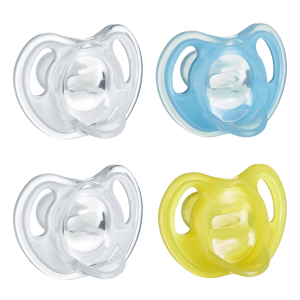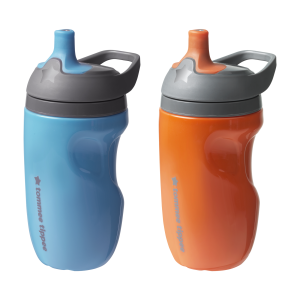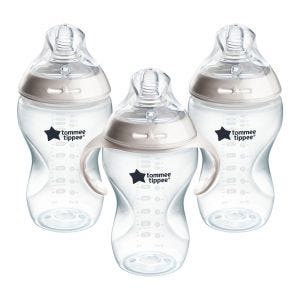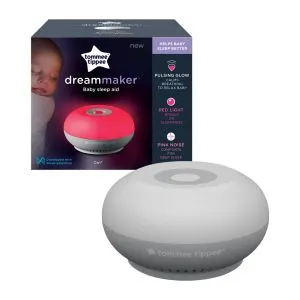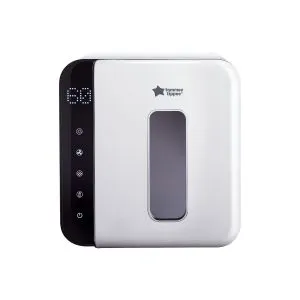
Tommee Tipps
So, you're getting ready to add complementary foods into your little one's diet and wondering “what does baby-led weaning mean?”.
What is Baby-Led Weaning?
So, you're getting ready to add complementary foods into your little one's diet and wondering “what does baby-led weaning mean?”.
Well, baby-led weaning (BLW) simply means letting your child feed themselves independently. The term was created in 2001 by Gill Rapley to describe a relaxed and unstructured approach where babies are offered solid foods and feed themselves.
We know that choosing a weaning style to suit you and your baby can feel daunting. So, read on to learn all about baby-led weaning, when to start, and what kind of foods you can offer.
The benefits of baby-led weaning
Yes, it can be a little messier than traditional weaning, but there are tons of benefits too!
The benefits of baby-led weaning include:
- Improved fine motor skills, chewing skills, and hand-eye coordination.
- It’s easier to prepare meals, as baby can eat the same foods as the whole family.
- Your little one enjoys a full sensory experience as they explore, inspect, and taste different food flavors and textures, developing good eating habits and introduction to a variety of foods.
- It allows them to develop independence (as your baby is in control and learns how to stop eating when they’re full). This can help to support healthy weight gain.
- It can be cheaper because you don’t need to buy pre-made purées.
- Making homemade baby food lets you know exactly what’s in their food.
- It makes picky eating and mealtime battles less likely. Mealtimes may be less stressful and more enjoyable.
When to start baby-led weaning
Although every weaning journey is different, most parents begin baby-led weaning when their baby is around six months old. This is the age when little ones start to hit the development milestones needed to eat independently.
The good thing about BLW is that it can work well for little ones of different ages and abilities. That said, babies who are born prematurely or who have difficulties eating may require more time or a more traditional, spoon-fed weaning approach.
Signs your little one is ready for self-led weaning
It's important to look out for certain cues that will let you know if your baby is ready to start baby-led weaning or not.
These include:
- Staying in a sitting position and holding their head steady.
- Coordinating their eyes, hands, and mouth so they're able to look at food, pick it up, and put it in their mouth.
- Swallowing food (rather than spitting or pushing it out).
- Making mouthing movements as they watch others eat and showing an interest in food.
How to start baby-led weaning
Instead of spoon-feeding babies, baby-led weaning involves setting out soft food in front of them on a table or highchair and allowing them to take control of feeding. The food is usually served in small, soft pieces that can be held in the baby's hand, rather than being offered on a spoon. First, they’ll use their hands, and gum, mash, and suck their food, before eventually moving on to using baby-friendly cutlery.
When you first start baby-led weaning from six months, most of your baby's nutritional needs will be met through their breast milk and formula feeds. These feeds should continue throughout their weaning journey.
What you’ll need for baby-led weaning
Before you start weaning your baby, it's a good idea to get prepared. The following items can help:
- A highchair
- A suitable first cup
- Baby-friendly weaning spoons
- A few bibs to protect their clothes from mess.
How to do self-led weaning safely
When they’re thinking about weaning their baby, lots of parents wonder “is baby-led weaning dangerous?”. The truth is, one recent study showed that there’s no increased choking risk for babies who feed themselves solid foods compared to spoon-fed infants. Therefore, baby-led weaning is no more dangerous.
Often, babies are not choking when they eat, but gagging. Gagging might look similar to choking and can be scary, but they're entirely different. So, it can help to know what to look out for.
Gagging is caused by your baby’s gag reflex. This is a natural safety mechanism we have to help prevent choking. Your little one may also gag on foods they're trying for the first time. This is because their taste buds aren't yet used to these new flavors and textures.
Gagging is sometimes mistaken for choking. But don’t worry, gagging is a perfectly normal part of tasting new foods. If you recognize the signs of gagging, don't try to help your baby or prevent them from vomiting, as this can cause them to choke.
Signs of gagging can include…
- Loudly gurgling, coughing, or sputtering
- Regurgitating swallowed food back into their mouth
- Baby’s tongue may be thrust forward
- Possible spitting up or vomiting
- Possible red face
And it's always important for parents to know the signs of choking. These include…
- Having difficulty breathing or coughing
- Having a terrified expression on their face
- Making high-pitched noises while breathing
- Face and lips that turn blue
- Struggling to make a sound
To keep your little one safe while weaning…
- Sit your baby upright, facing the table, either on your lap or in a highchair. Make sure they can sit steadily and can use their hands and arms freely.
- Never leave them alone with food and always monitor them at mealtimes.
- Discuss the introduction of solids with your health advisers if your family has a history of food intolerance, digestive issues, allergies, or any other concerns about your baby’s health or development.
Top baby-led weaning ideas and tips
- You can lay a wipe-clean tablecloth under the highchair and pop a bibon your baby to catch any mess.
- Offer your baby food, rather than giving it to them. Put it in front of them or let them take it from your hand so that the decision is theirs.
- Involve your baby in your mealtimes and if it’s suitable, you can give them the same meal that you're eating at a smaller scale. That way, they can learn to copy you.
- Set mealtimes when your baby isn't tired or too hungry, so they can concentrate on learning new skills.
- You can also offer waterin small amounts during mealtime in an open cup as early as six months to help baby develop their oral motor skills.
- Many babies eat only small amounts for the first few months of baby-led weaning. For them, these early mealtimes are about discovering and learning rather than eating. You'll know when your baby is finished eating if they turn their head away and shut their mouth. If they show these signs, don’t keep feeding them and trust their cues. They'll let you know when they're feeling peckish again!
- Remember, try to stay positive. Keep smiling, enjoying, and paying attention. If you keep it enjoyable, your baby will be keen to try new foods and look forward to mealtimes.
- Weaning is a very short time in your child's life. Remember to enjoy it and have a camera ready to capture their first gummy, carroty smiles!
Molly says "When it comes to weaning a toddler, the truth is that it gets messy! We did baby-led weaning, and my kitchen was a tip, but seeing how amazed my little boy was by food cancelled out the mess he left in the kitchen".
Sarah and Laura found that when they "began weaning, it opened up a whole new experience for us. It can get messy, but it's also really fun and exciting. We spent hours looking online and through books to find recipes, and it was amazing to introduce our little girl to new foods".
Best BLW foods
There's no set amount of food that babies should eat during the BLW process. The idea of this method of weaning is that they'll tell you when they’ve had enough. Plus, since they're still having breast milk or formula until they're at least a year old, they're sure to get all the calories they need.
- At first, you can start with steamed, sliced veggies that your baby can chew and swallow easily. Whatever they're able to hold, squash, and sensibly chew, or gum! That's the essence of it.
- Give soft fruits and vegetables at first, and then introduce lightly cooked foods that can be chewed or gummed.
- All foods you give need to be soft enough to be mashed with the tongue or between your fingers.
- Good first foods for baby-led weaning include avocado, banana, steamed sweet potato, or steamed carrots.
- Your baby's first foods should be baton-shaped like a finger, and easily fit in their little hand.
- You can try to introduce one new food each day for your baby to explore. This way, they have a variety of foods and discover more options they enjoy. You can also see what kind of foods or shapes they prefer.
BLW foods: 6 months
- Soft, mashed, or blended vegetables and fruit, such as broccoli, carrot, sweet potato, apple, and pear
- Baby rice mixed with breast milk or formula
- Toast strips
- Unflavoured Greek yogurt
- Soft cheese, like ricotta or mozzarella
- Steamed strips of tofu
- Unflavoured pureed meat, such as chicken, turkey, or beef, that’s shaped into sticks or strips
- Very small amounts of foods that may trigger an allergic reaction (these should be introduced one at a time). These can include cow’s milk that has been mixed with food, cooked eggs, crushed nuts and seeds, soya, cooked shellfish, and fish.
BLW foods: 7-9 months
- Thinly sliced or halved fruits, like strawberries, blueberries, and raspberries
- Harder cheese, like Swiss or cheddar, that’s cubed or grated
- Cooked whole-wheat pasta
- Cooked pulses and beans
- Whole grain cereal O-s
- Minced meat and halved meatballs
BLW foods: 10-12 months
At this age, babies should be having three meals a day – with lunch and dinner including a main course and dessert of fruit or plain yogurt.
Baby-led weaning recipes
Variety is the spice of life, and weaning is no different! There are tons of great websites, books, and blogs you can use for research to inspire your baby-led weaning journey.
Here are a few to get you started:
Baby-led weaning FAQs
Do pediatricians recommend baby-led weaning?
Many pediatric experts recommend starting your baby on solid foods from six months because it helps them develop independent feeding skills. At this age, your baby should be developmentally ready to handle solid foods, but they will still be getting most of their nutrition from breast milk or formula feeds.
How do you do baby-led weaning without the mess?
The truth is, baby-led weaning is a messy process, but there are ways to help manage the mess of self-feeding. This includes using bibs and mats to help catch food and minimize waste.
Can I combine baby-led weaning with traditional spoon-fed weaning?
Absolutely! Some parents love baby-led weaning and prefer it to traditional spoon feeding, while others use a bit of both.
As with most parenting topics, there isn’t one right or perfect way, just what feels right for you and your baby. The main thing is that your baby has a healthy, varied diet, and gets all the important nutrients they need to grow and develop.
Are there any foods my baby shouldn’t have?
While there are plenty of new tastes they can discover through baby-led weaning, there are a few foods you should steer clear of for your baby or toddler.
Along with added salt, sugar, and saturated fats, this includes honey (for babies under the age of one due to the risk of botulism), rice-based drinks (as they contain levels of arsenic), mould-ripened cheese, and certain seafood – including swordfish, shark, and marlin (as they contain mercury). Additionally, raw, or undercooked shellfish and eggs can pose a health risk.
You should also avoid giving your baby anything that poses a choking risk. This can include peanuts and whole nuts, raisins and other dried fruits, popcorn, boiled sweets, raw jelly cubes, or ice cubes.
Sources

